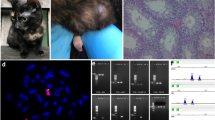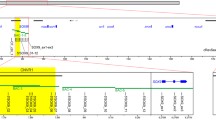Abstract
A 9-month-old Yorkshire terrier was admitted to the clinic because of abnormal sexual behaviour and clitoral hypertrophy. External examination confirmed standard development of caudal genital organs: vagina, vulva and cervix uteri. Serum profile of gonadotropin hormones 17 β-estradiol (<10.0 pg.ml−1) and testosterone (9.1 ng.ml−1) revealed the presence of testicular tissue. A midline laparotomy was performed to detect the cranial parts of the genital system. Gonads resembling testicles, structures indicating epididymis and rudimentary deferent ducts were resected, along with adherent part of the uterus. Cytogenetic analysis showed a male chromosomal complement 78, XY in all metaphases of the studied Yorkshire terrier dog. The chromosomal constitution was confirmed by fluorescence in situ hybridisation (FISH) with whole-chromosome painting probes specific for chromosomes X and Y, as well as by polymerase chain reaction (PCR) amplification of the 271-bp Y-linked fragment of SRY (the sex-determining region on the Y chromosome) gene. Sequencing of the dog’s SRY gene coding region did not reveal any mutation. To search for potential mutation in the SOX9 gene (Sry-box containing gene 9), which is considered to be one of the key genes involved in the sex determination process, the PCR fragments of exons 1, 2 and 3 originating from the canine patient were sequenced in order to compare with both male and female healthy control dogs. In the analysed regions of the SOX9 gene, no mutation was found.



Similar content being viewed by others
References
Adelsberger ME, Smeak DD (2009) Repair of extensive perineal hypospadias in a Boston terrier using tubularized incised plate urethroplasty. Can Vet J 50:937–942
Ader PL, Hobson HP (1978) Hypospadias: a review of the veterinary literature and a report of three cases in the dog. J Am Anim Hosp Assoc 14:721–727
Alam MR, Cho YG, Cho SJ, Lee JI, Lee HB, Tae HJ, Kim IS, Kim NS (2007) Male pseudohermaphroditism in dogs: three case reports. Vet Med 52:74–78
Barasc H, Mary N, Letron R, Calgaro A, Dudez AM, Bonnet N, Lahbib-Mansais Y, Yerle M, Ducos A, Pinton A (2012) Y-autosome translocation interferes with meiotic sex inactivation and expression of autosomal genes: a case study in the pig. Sex Dev 6:143–150
Bigliardi E, Parma P, Peressotti P, De Lorenzi L, Wohlsein P, Passeri B, Jottini S, Cantoni AM (2011) Clinical, genetic, and pathological features of male pseudohermaphroditism in dog. Reprod Biol Endocrinol 9:12
Brown TT, Burek JD, McEntee K (1976) Male pseudohermaphroditism, cryptorchism, and Sertoli cell neoplasia in three miniature Schnauzers. J Am Vet Med Assoc 169:821–825
Christensen BW (2012) Disorders of sexual development in dogs and cats. Vet Clin North Am Small Anim Pract 42:515–526
De Lorenzi L, Groppetti D, Arrighi S, Pujar S, Nicoloso L, Molteni L, Pecile A, Cremonesi F, Parma P, Meyers-Wallen V (2008) Mutations in the RSPO1 coding region are not the main cause of canine SRY-negative XX sex reversal in several breeds. Sex Dev 2:84–95
Hagel T, Baade S, Kirchhoff A, Kuiper H, Perk A (2010) Persistent Mullerian duct syndrome in a Yorkshire terrier. Kleintierpraxis 55:547
Hayes HM Jr, Wilson GP, Pendergrass TW, Cox VS (1985) Canine cryptorchism and subsequent testicular neoplasia: case–control study with epidemiologic update. Teratology 32:51–56
Jurka P, Galanty M, Zielinska P, Max A, Sysa P (2009) Hypospadias in six dogs. Vet Rec 164:331–333
Klein OD, Backstrand K, Cotter PD, Marco E, Sherr E, Slavotinek A (2005) Case report: Y;6 translocation with deletion of 6p. Clin Dysmorphol 14:93–96
Kubíčková S, Černohorská H, Musilová P, Rubeš J (2002) The use of laser microdissection for the preparation of chromosome-specific painting probes in farm animals. Chromosome Res 10:571–577
Lyle SK (2007) Disorders of sexual development in the dog and cat. Theriogenology 68:338–343
Marshall LS, Oehlert ML, Haskins ME, Selden JR, Patterson DF (1982) Persistent Müllerian duct syndrome in miniature schnauzers. J Am Vet Med Assoc 181:798–801
Meyers-Wallen VN (2003) Sry and Sox9 expression during canine gonadal sex determination assayed by quantitative reverse transcription-polymerase chain reaction. Mol Reprod Dev 65:373–381
Meyers-Wallen VN (2006) Genetics, genomics, and molecular biology of sex determination in small animals. Theriogenology 66:1655–1658
Meyers-Wallen VN (2012) Gonadal and sex differentiation abnormalities of dogs and cats. Sex Dev 6:46–60
Meyers-Wallen VN, Bowman L, Acland GM, Palmer VL, Schlafer D, Fajt V (1995) Sry-negative XX sex reversal in the German shorthaired pointer dog. J Hered 86:369–374
Ninomiya S, Yokoyama Y, Teraoka M, Mori R, Inoue C, Yamashita S, Tamai H, Funato M, Seino Y (2000) A novel mutation (296 del G) of the SOX90 gene in a patient with campomelic syndrome and sex reversal. Clin Genet 58:224–227
Nowacka J, Nizanski W, Klimowicz M, Dzimira S, Switonski M (2005) Lack of the SOX9 gene polymorphism in sex reversal dogs (78, XX; SRY negative). J Hered 96:797–802
Nowacka-Woszuk J, Switonski M (2009) Differentiated evolutionary conservatism and lack of polymorphism of crucial sex determination genes (SRY and SOX9) in four species of the family Canidae. Folia Biol (Krakow) 57:171–176
Nowacka-Woszuk J, Switonski M (2010) Comparative cytogenetic mapping of three genes involved in sex determination in four species of the family Canidae. J Anim Feed Sci 19:5–12
Nowacka-Woszuk J, Nizanski W, Klimowicz M, Switonski M (2007) Normal male chromosome complement and a lack of the SRY and SOX9 gene mutations in a male pseudohermaphrodite dog. Anim Reprod Sci 98:371–376
Poth T, Breuer W, Walter B, Hecht W, Hermanns W (2010) Disorders of sex development in the dog—adoption of a new nomenclature and reclassification of reported cases. Anim Reprod Sci 121:197–207
Preiss S, Argentaro A, Clayton A, John A, Jans DA, Ogata T, Nagai T, Barroso I, Schafer AJ, Harley VR (2001) Compound effects of point mutations causing campomelic dysplasia/autosomal sex reversal upon SOX9 structure, nuclear transport, DNA binding, and transcriptional activation. J Biol Chem 276:27864–27872
Pujar S, Meyers-Wallen VN (2009) A molecular diagnostic test for persistent Müllerian duct syndrome in miniature schnauzer dogs. Sex Dev 3:326–328
Pujar S, Kothapalli KS, Kirkness E, Van Wormer RH, Meyers-Wallen VN (2005) Exclusion of Lhx9 as a candidate gene for Sry-negative XX sex reversal in the American cocker spaniel model. J Hered 96:452–454
Rijnberk A, Kooistra HS (2010) Clinical endocrinology of dogs and cats. Schlutersche Verlagsgesellschaft mbH & Co, Hannover
Rota A, Cucuzza AS, Iussich S, DeLorenzi L, Parma P (2010) The case of an Sry-negative XX male Pug with an inguinal gonad. Reprod Domest Anim 45:743–745
Schelling C, Pieńkowska A, Arnold S, Hauser B, Switoński M (2001) A male to female sex-reversed dog with a reciprocal translocation. J Reprod Fertil Suppl 57:435–438
Seabright M (1971) A rapid banding technique for human chromosomes. Lancet 2:971–972
Switoński M, Reimann N, Bosma AA, Long S, Bartnitzke S, Pieńkowska A, Moreno-Milan MM, Fischer P (1996) Report on the progress of standardization of the G-banded canine (Canis familiaris) karyotype. Committee for the Standardized Karyotype of the Dog (Canis familiaris). Chromosome Res 4:306–309
Switonski M, Szczerbal I, Nizanski W, Kociucka B, Bartz M, Dzimira S, Mikolajewska N (2011) Robertsonian translocation in a sex reversal dog (XX, SRY negative) may indicate that the causative mutation for this intersexuality syndrome resides on canine chromosome 23 (CFA23). Sex Dev 5:141–146
Switonski M, Payan-Carreira R, Bartz M, Nowacka-Woszuk J, Szczerbal I, Colaço B, Pires MA, Ochota M, Nizanski W (2012) Hypospadias in a male (78,XY; SRY-positive) dog and sex reversal female (78,XX; SRY-negative) dogs: clinical, histological and genetic studies. Sex Dev 6:128–134
Volpe P, Izzo B, Di Meo GP, Perucatti A, Iannuzzi L (2000) Male pseudo-hermaphroditism in a dog: a clinical case. Vet Rec 146:532–533
Wu X, Wan S, Pujar S, Haskins ME, Schlafer DH, Lee MM, Meyers-Wallen VN (2009) A single base pair mutation encoding a premature stop codon in the MIS type II receptor is responsible for canine persistent Müllerian duct syndrome. J Androl 30:46–56
Yates D, Hayes G, Heffernan M, Beynon R (2003) Incidence of cryptorchidism in dogs and cats. Vet Rec 152:502–504
Acknowledgements
The authors would like to thank Dr. Petra Musilová and Dr. Svatava Kubíčková (Department of Genetics and Reproduction, Veterinary Research Institute, Brno, Czech Republic) for their kind personal communication in relation to the dog FISH probes and Dr. Ľudmila Tkáčiková (Department of Microbiology and Immunology, University of Veterinary Medicine and Pharmacy, Košice, Slovak Republic) for the PCR consultations, as well as Dr. Mangesh Bhide and Dr. Stanislav Hreško (Laboratory of Biomedical Microbiology and Immunology, University of Veterinary Medicine and Pharmacy, Košice, Slovak Republic) for their helpful advice and evaluation of the DNA sequencing results.
Funding
This work was supported by VEGA grants 1/0125/11 and 1/0117/13.
Author information
Authors and Affiliations
Corresponding author
Rights and permissions
About this article
Cite this article
Dianovský, J., Holečková, B., Hajurka, J. et al. Disorder of sexual development in a Yorkshire terrier (78, XY; SRY-positive). J Appl Genetics 54, 193–199 (2013). https://doi.org/10.1007/s13353-013-0137-1
Received:
Revised:
Accepted:
Published:
Issue Date:
DOI: https://doi.org/10.1007/s13353-013-0137-1




